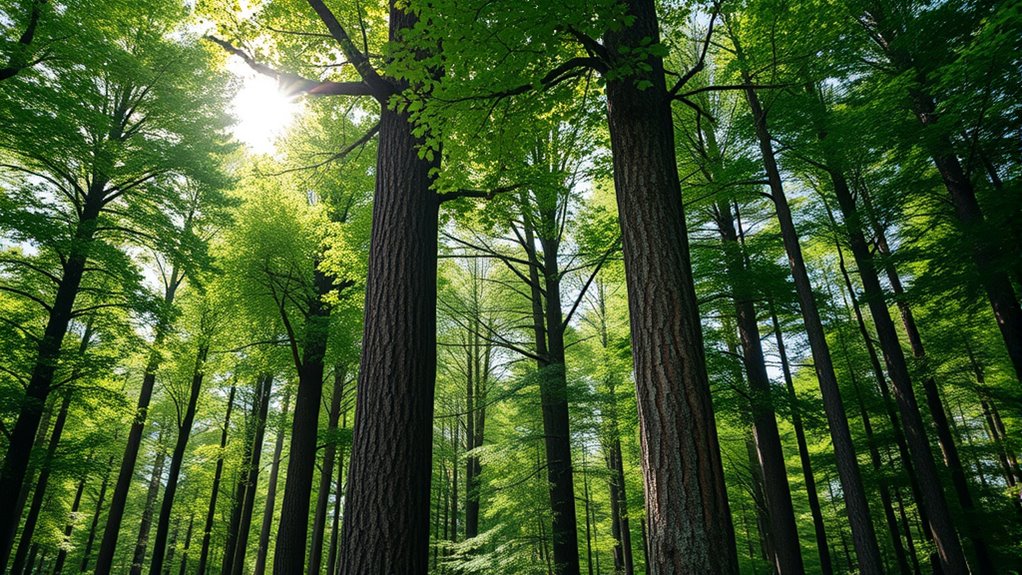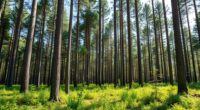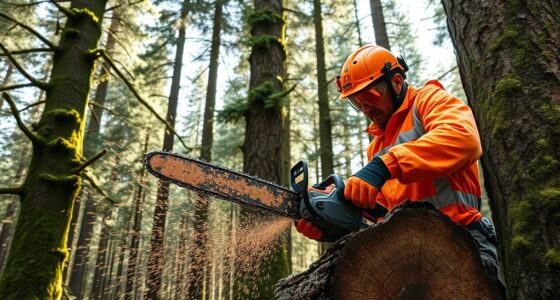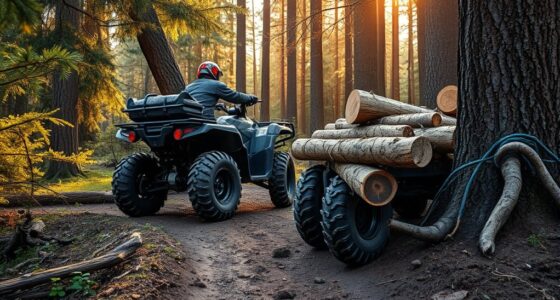To select trees for sustainable harvest, focus on their ecological roles, growth rates, and resilience traits. Prioritize native and endemic species that support biodiversity and natural regeneration. Assess each tree’s contribution to forest diversity and structure, and consider their ability to withstand environmental stresses. Implement responsible management practices that protect mature trees and seed dispersal processes. Continuing will help you understand how to balance harvests with forest health and longevity.
Key Takeaways
- Assess tree growth rates using DBH and height measurements to determine optimal harvest timing.
- Prioritize native and endemic species to support local biodiversity and ecological stability.
- Select resilient trees with traits like drought tolerance and strong root systems for long-term sustainability.
- Maintain seed dispersal processes and protect mature trees with effective canopy architecture for natural regeneration.
- Utilize remote sensing and monitoring data to adapt harvest plans based on forest health, regeneration, and ecological impacts.
Understanding the Ecological Roles of Tree Species
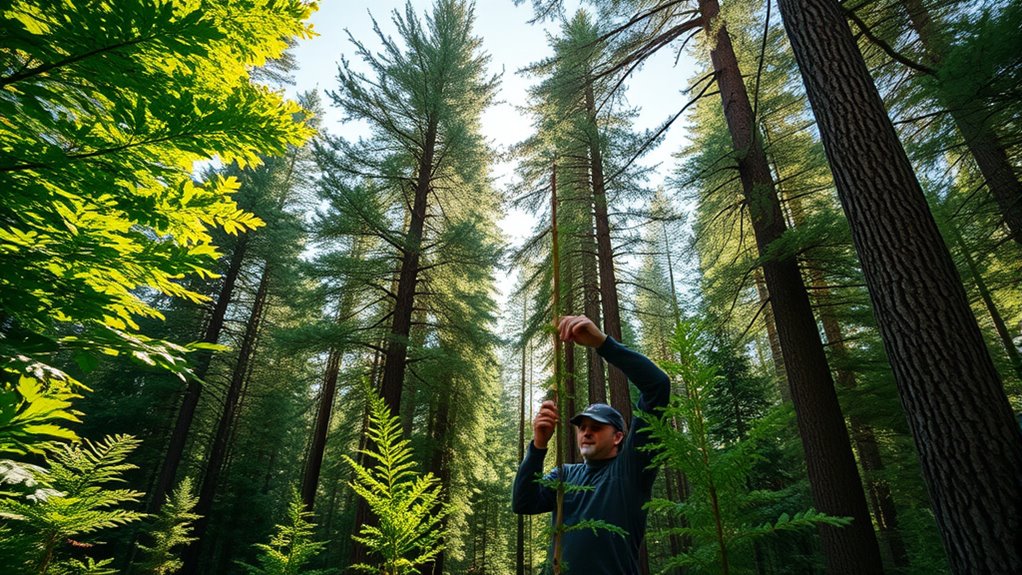
Understanding the ecological roles of tree species is fundamental for sustainable harvesting because each species contributes uniquely to the health and balance of their ecosystems. You need to recognize how trees support pollination ecology, attracting specific pollinators that guarantee successful reproduction. Additionally, seed dispersal mechanisms are essential; some trees rely on animals, wind, or water to spread their seeds effectively. By understanding these roles, you can identify which trees are indispensable for maintaining biodiversity and ecosystem stability. Overharvesting certain species can disrupt pollination networks or seed dispersal processes, leading to ecological imbalance. Thus, studying these ecological functions helps you make informed decisions that preserve the natural regeneration cycles, guaranteeing that harvesting practices support long-term sustainability and ecosystem resilience. Recognizing the benefits of adjustable settings in equipment like sprayers can also aid in minimizing environmental impact during harvesting practices.
Assessing Growth Rates and Harvest Cycles
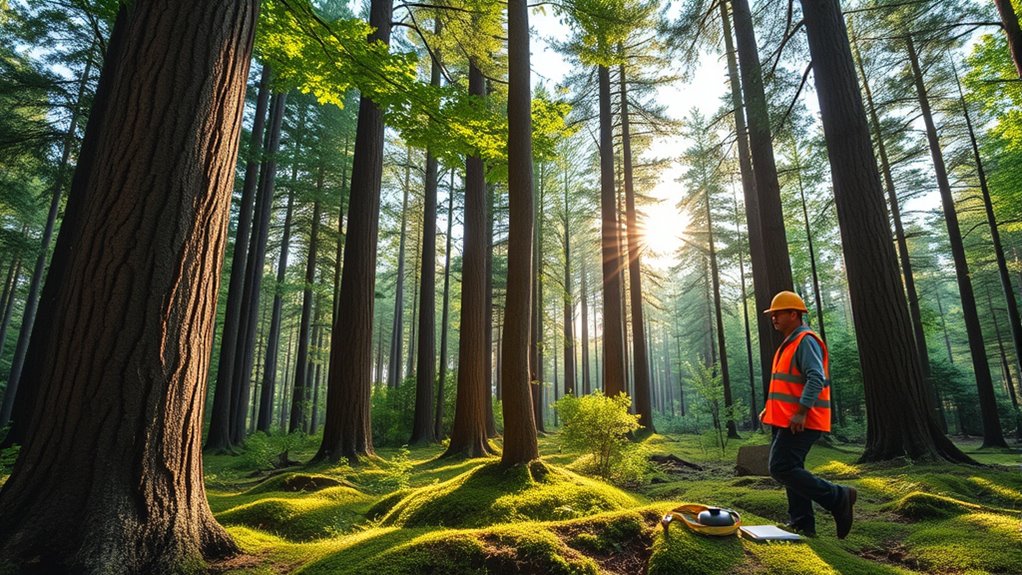
To guarantee sustainable harvesting, you need to accurately measure how quickly trees grow. Planning appropriate harvest intervals depends on understanding these growth rates. By doing so, you can avoid overharvesting and promote healthy forest regeneration.
Measuring Tree Growth Speed
Measuring tree growth speed is essential for determining the ideal harvest cycle and ensuring sustainability. You should focus on growth measurement techniques, such as measuring diameter at breast height (DBH) and tree height regularly. These methods help you monitor how quickly a tree gains biomass over time. Consistent tree monitoring allows you to track seasonal or annual changes, providing accurate data on growth rates. By understanding how fast a tree grows, you can plan harvest intervals that balance timber yield with forest health. Accurate growth data helps avoid overharvesting, ensuring the forest remains productive for future cycles. Regular monitoring also enables early detection of growth issues, supporting adaptive management practices for long-term sustainability. Additionally, understanding the nutritional value of juices can inform sustainable harvesting practices by promoting the use of leaves and fruits that contribute to the ecosystem’s health. Incorporating growth rate analysis can further optimize harvest timing and improve forest management strategies. Furthermore, utilizing growth monitoring techniques ensures timely decisions that sustain forest productivity and ecological balance. For instance, integrating AI-powered data analytics can enhance monitoring accuracy and efficiency.
Planning Harvest Intervals
Planning harvest intervals requires you to evaluate growth rates carefully to determine the most favorable timing for timber extraction. By understanding how quickly trees grow, you can optimize harvest cycles to meet market demand while maintaining forest health. Timber certification standards emphasize sustainable practices, so aligning harvest timing with growth patterns helps ensure your forest remains productive over the long term. Regularly appraising growth rates allows you to identify the ideal harvest age, preventing premature cutting or unnecessary delays. This strategic approach supports sustainable management and enhances your ability to meet market demand efficiently. Properly planned harvest intervals also demonstrate responsible forestry practices, which can improve your chances of obtaining and maintaining timber certification. Additionally, understanding growth rates is essential for aligning harvest cycles with ecological health and market needs. Overall, careful planning ensures balanced, sustainable harvests that benefit both your operation and the environment.
Evaluating Resilience to Environmental Stressors
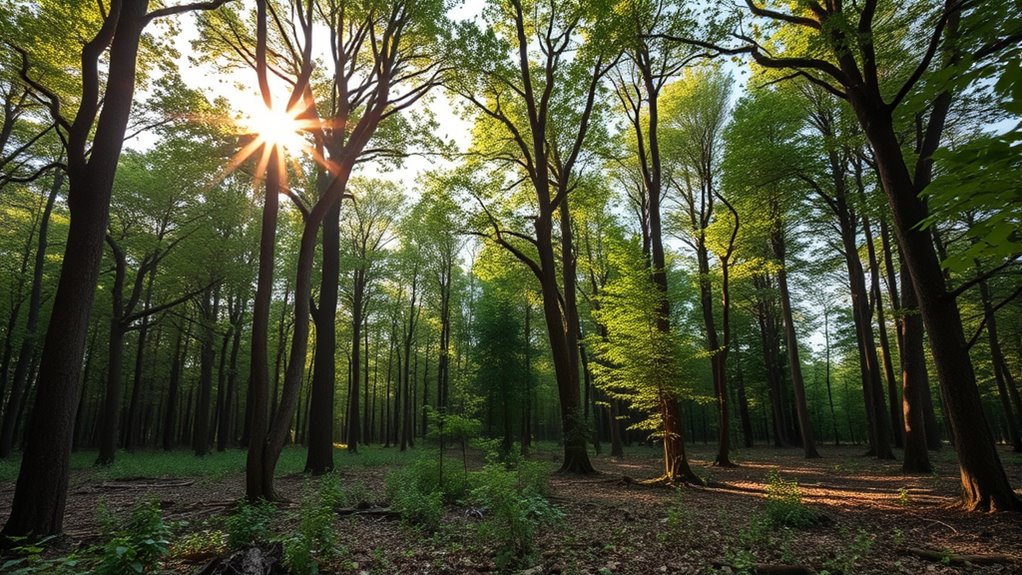
Evaluating a tree’s resilience to environmental stressors is vital for ensuring sustainable harvests. You need to consider genetic diversity, which boosts a species’ ability to withstand various challenges, including pests and diseases. Climate adaptability is equally important; trees that thrive across changing conditions are more likely to survive droughts, storms, and temperature fluctuations. When assessing resilience, examine traits like root strength, bark thickness, and leaf durability, as well as genetic variability within the population. Trees with high genetic diversity tend to adapt better to environmental stressors, ensuring their long-term health and productivity. Additionally, selecting trees with proven climate adaptability can improve resilience to future environmental changes. Incorporating genetic screening into selection processes can further enhance the identification of resilient specimens. Understanding specific breed traits, such as those found in Dog breeds, can inform selection strategies for resilient trees. For example, selecting for traits like drought tolerance or pest resistance may be influenced by personality traits linked to genetic factors. By focusing on these factors, you can select trees that are better equipped to endure stress, supporting sustainable harvesting practices and preserving forest stability for future generations. Recognizing the role of genetic diversity is essential in fostering resilient forests capable of adapting to ongoing environmental shifts.
Prioritizing Native and Endemic Species
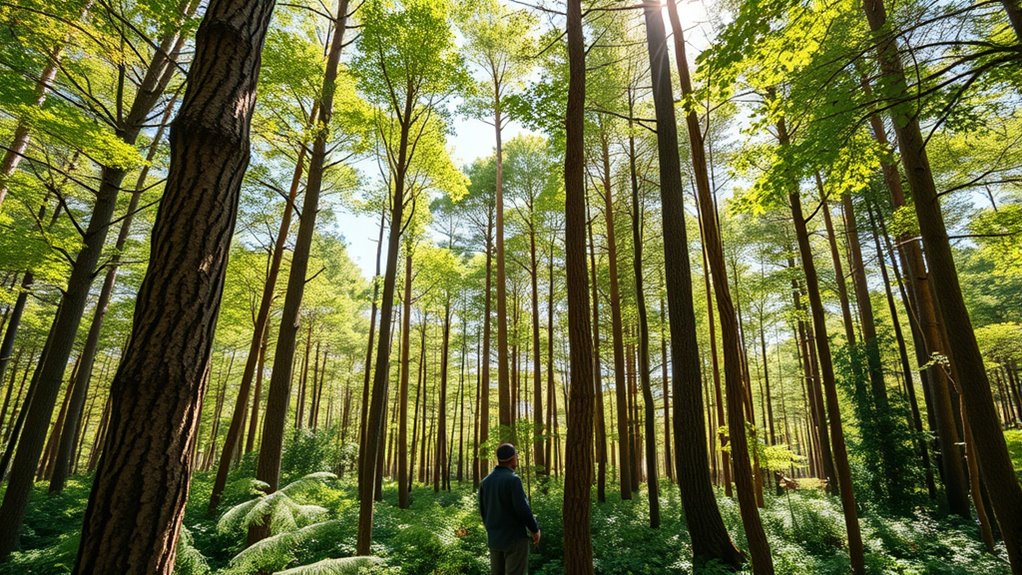
Choosing native species helps maintain local ecosystems and supports biodiversity. Protecting endemic trees guarantees the unique character of the region isn’t lost. Prioritizing these trees is essential for sustainable and resilient forest management. Additionally, understanding the refrigeration cycle aids in implementing environmentally friendly practices and reducing carbon footprints in forestry operations. As automation technologies advance, they can also assist in monitoring biodiversity and ensuring conservation efforts are effectively managed. Incorporating mindfulness techniques into forestry practices can foster more thoughtful and sustainable decision-making, promoting long-term ecological health.
Benefits of Native Species
Native and endemic species play a crucial role in maintaining healthy and resilient ecosystems. They support local biodiversity, ensuring balanced food webs and habitat stability. By choosing native trees, you help prevent the spread of invasive species that threaten native flora and fauna. In urban forestry, native trees adapt better to local conditions, reducing maintenance and water needs. Imagine:
- A canopy that provides shade, cooling streets naturally
- Birds and insects thriving on native plants, boosting pollination
- Roots stabilizing soil and preventing erosion
- Less need for chemical treatments, promoting healthier environments
Prioritizing native species fosters ecosystem resilience and reduces invasive species spread, creating sustainable urban green spaces that benefit both people and wildlife. Additionally, using native trees supports local biodiversity, which is essential for overall ecosystem health and stability.
Protecting Endemic Trees
Why should you prioritize protecting endemic trees in your forest management efforts? Endemic trees play a crucial role in maintaining ecosystem stability through seed dispersal, ensuring their populations continue thriving. They often occupy specific niches within canopy layering, supporting diverse plant and animal species. Protecting these native species helps preserve genetic diversity and prevents invasive species from taking hold. Additionally, conserving endemic trees can boost local biodiversity by providing habitat and food sources for specialized wildlife. Endemic trees also sustain wildlife that relies on them for food and habitat. When you focus on their conservation, you support natural regeneration processes and uphold the ecological balance. Recognizing the ecological significance of native species can further inform targeted conservation efforts and inspire community engagement in preservation initiatives. Moreover, understanding the threats faced by endemic species can help develop more effective protection strategies. Additionally, understanding the optimal angles for pinball machines can inspire innovative ways to engage with nature and promote environmental awareness. Recognizing the importance of native species in local ecosystems emphasizes the need for targeted conservation strategies to support their survival.
Considering Forest Diversity and Structure
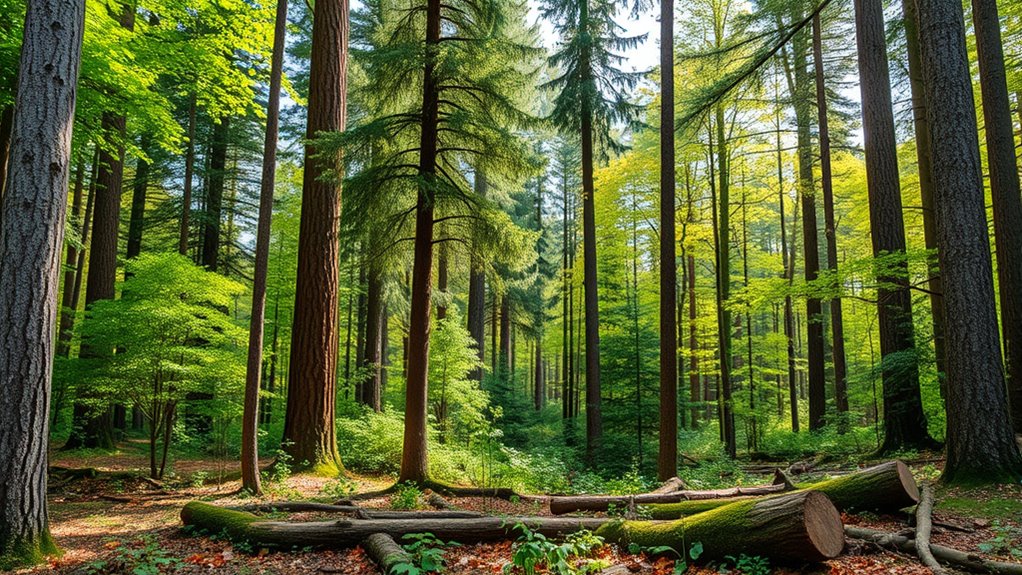
Understanding forest diversity and structure is essential for sustainable harvesting because it directly influences the health and resilience of the ecosystem. When you consider biodiversity hotspots, you recognize areas teeming with varied plant and animal species. Focus on canopy complexity, which includes layered branches, leaves, and gaps that support diverse life forms. Visualize these elements:
- A dense, multi-layered canopy with interwoven branches
- Patches of rich understory vegetation
- Varied tree sizes and ages scattered throughout
- Critical habitats supporting endemic and rare species
Implementing Responsible Management Practices
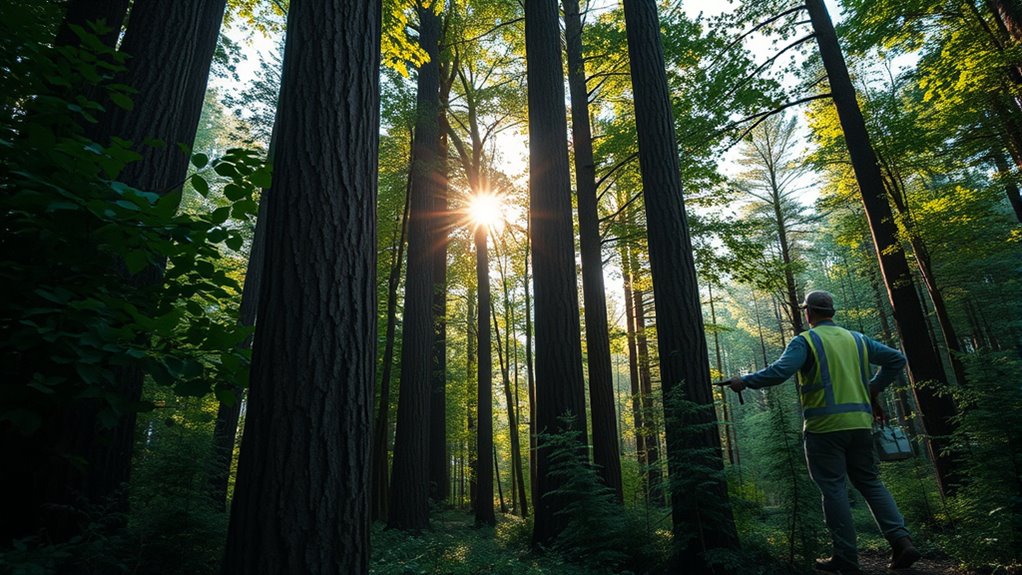
Implementing responsible management practices is essential for ensuring the long-term sustainability of forest resources. You should focus on maintaining healthy seed dispersal processes, which are crucial for natural regeneration. Protecting mature trees with effective canopy architecture helps facilitate this process, as it influences seed release and dispersal patterns. By understanding canopy structure, you can identify which trees contribute most to seed spread and prioritize their conservation. Avoid practices that damage seed-producing trees or disrupt their ability to disperse seeds. Incorporate techniques that promote natural regeneration, such as leaving seed trees standing and managing for diverse canopy layers. These strategies support resilient forests, ensuring that future harvests are sustainable and that the ecological functions of the forest remain intact.
Monitoring and Adapting Harvest Strategies
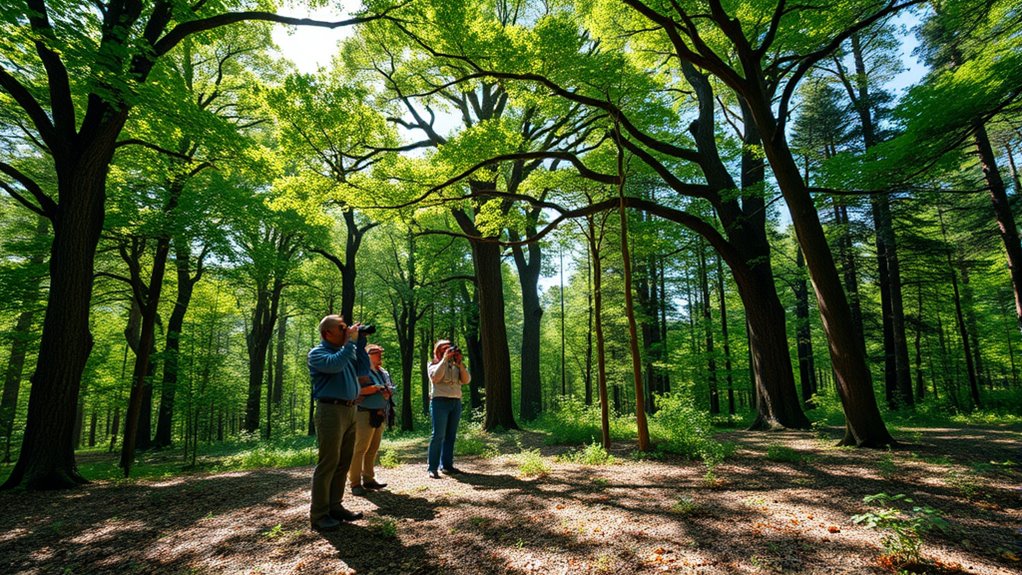
Effective forest management requires ongoing oversight to guarantee harvest methods support long-term sustainability. To do this, you must use monitoring tools like remote sensing and on-the-ground surveys. These tools help you track forest health, growth rates, and regeneration. You can then apply adaptive techniques by adjusting your strategies based on the data collected. Imagine:
Ongoing forest oversight ensures sustainable harvests through monitoring, data analysis, and adaptive management strategies.
- Analyzing satellite images to detect changes in canopy cover.
- Conducting periodic field inventories to assess tree growth.
- Using drone technology for real-time monitoring of harvest areas.
- Revising harvest plans based on observed regeneration patterns.
This continuous process allows you to respond swiftly to emerging challenges, ensuring your harvest strategies remain sustainable and effective over time. Monitoring and adapting are key to maintaining healthy forests for future generations.
Frequently Asked Questions
How Can Local Communities Participate in Sustainable Tree Harvesting?
You can participate in sustainable tree harvesting by engaging with your community and sharing traditional knowledge about local trees. Get involved in community meetings, support local conservation initiatives, and learn from elders who understand sustainable practices. Your active participation helps protect forest resources, ensuring future generations can benefit. By collaborating and respecting traditional wisdom, you contribute to responsible harvesting that balances ecological health with community needs.
What Economic Incentives Promote Sustainable Forestry Practices?
You can benefit from market-based incentives like certification programs that reward sustainable forestry, encouraging you to adopt eco-friendly practices. Policy frameworks, such as government subsidies or tax breaks, also motivate you to prioritize forest conservation. These economic incentives align your interests with sustainable harvest goals, helping you maintain healthy forests while enjoying financial gains. By leveraging these tools, you actively contribute to long-term forest health and resource availability.
How Do Climate Change Impacts Influence Tree Selection Decisions?
Climate change impacts greatly influence your tree selection decisions by emphasizing climate adaptation and species resilience. You need to choose species that can endure changing temperatures, altered rainfall patterns, and extreme weather events. By prioritizing resilient species, you help ensure forest health and sustainability. This proactive approach allows forests to adapt naturally, securing their ecological functions and economic benefits despite ongoing climate challenges.
What Are the Most Effective Tools for Monitoring Forest Health?
You might think monitoring forest health relies only on ground inspections, but remote sensing proves more effective. It allows you to observe large forest areas quickly, detecting changes like pest infestations early. This technology enhances pest management by providing timely data, helping you make informed decisions. By integrating remote sensing tools into your practices, you improve your ability to maintain healthy forests and guarantee sustainable harvesting.
How Can Technology Improve Sustainable Harvest Planning?
Technology can substantially improve sustainable harvest planning by utilizing remote sensing to monitor forest conditions and track changes over time. You can analyze data quickly, making informed decisions about harvest areas. Additionally, understanding genetic diversity helps you select trees that promote resilient forests. By integrating these tools, you optimize resource use, protect ecosystems, and guarantee long-term forest health, making your harvest practices more sustainable and environmentally responsible.
Conclusion
By choosing the right trees for sustainable harvest, you protect ecosystems and guarantee future generations can enjoy their beauty and benefits. Some might worry it limits economic growth, but your responsible actions can foster thriving forests and communities. When you prioritize ecological health over short-term gains, you create a legacy of resilience and hope. Your commitment matters—because a sustainable forest isn’t just good for nature, it’s essential for our shared future.
